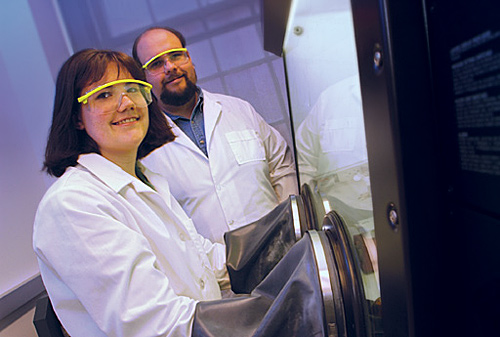Chip Nataro, assistant professor of chemistry at Lafayette, has received a $35,000 grant from the Petroleum Research Fund administered by the American Chemical Society to continue research with students that will help the chemical community know when certain compounds are ideal to use without having to test them.
“Lafayette students will be a major part of this research,” says Nataro. “My students have done some great work to date, and I would say that was a big help in getting this grant. We are looking to build on the work we have already accomplished and hopefully answer some very interesting questions.”
Funding for the project, entitled “Electrochemical Investigation of 1,1′ Bis(diphenylphosphino)metallocenes,” will go toward paying students for their assistance and enabling them to present their research at the 224th National Meeting of the American Chemical Society from Aug. 18-22 in Boston, Mass.
Some preliminary work for the project has been conducted through Lafayette’s EXCEL Scholars program by chemistry major Abby O’Connor ’03 (Newton, N.J.) and biochemistry majors Amanda Ohs ’03 (St. Paul, Minn.), Michelle Ferguson ’04 (Wallingford, Conn.), and Alison Campbell ’04 (West Chester, Pa.). All presented their research at the Intercollegiate Student Chemists Convention this spring, and all but Ferguson will work on the project with Nataro during the fall semester. In EXCEL, students assist faculty with research while earning a stipend.
“We are looking at a series of compounds that have two interesting features,” says Nataro. “First, these compounds have a metal atom at the center. Second, there is a phosphorus atom at both ends of the molecule. These phosphorus atoms are capable of grabbing a second metal atom. When our molecule grabs a second metal, it is called a ligand. The unique part of our molecule acting as a ligand is that it has a metal atom at the center. There are many ligands with two phosphorus atoms, but few with a metal atom in the center.”
Many studies have shown that the type of ligands the Lafayette researchers are studying behave differently than those without a metal center. They become more reactive in some cases and less reactive in others.
“The reason for these differences is not understood, and that is where we hope to answer some questions,” Nataro explains. “To begin with, we will be looking at the free molecule. We have to understand how it behaves before we bond it to a second metal. We are going to use two techniques, electrochemistry and titration calorimetry, to probe the compounds. Once we have an understanding of the compounds, we will investigate what happens when they become ligands.”
Accompanied by Nataro, O’Connor and Ohs presented research on the project last fall at the 20th annual Esther B. and Bingham J. Humphrey Memorial Symposium at the University of Vermont. The event included a series of lectures by some of the foremost chemists in the country, including Alan Bard, last year’s winner of the Priestly Medal, the highest award given by the American Chemical Society.
“The students got to discuss their work with some of the best chemists in their fields,” says Nataro. “They obtained some excellent insight into their work and received some very nice compliments. Dr. William Geiger — in my opinion the best organometallic electrochemist in the country — was very impressed that this was the work of undergraduates.”
“One of the best things that Lafayette offers to its students is research opportunities,” says O’Connor. “Never could I have imagined the chance to gain this much exposure to research at this level. Lafayette provides such an excellent environment for research. Hugel Science Center has state-of-the-art instruments and laboratories. The campus is small enough so those who want the chance to do research have the opportunity to do so. My choice to come to Lafayette was definitely the best decision I ever made, and this is mainly due to my ability to do research and investigate ideas on a whole other level. Lafayette is a great college that offers nothing but the best to the student body.”
“Lafayette has wonderful facilities,” adds Ohs. “The small, strictly undergraduate atmosphere allows the students to get opportunities they wouldn’t have elsewhere and that puts us ahead of most other students.”
According to Campbell, “Research at Lafayette is backed up by both funding and faculty support. The EXCEL Scholars program provides an outstanding supplemental learning environment where faculty encourage student involvement beyond the classroom and connect with students to support these efforts. Their commitment and enthusiasm are truly contagious.”
Nataro has worked with seven EXCEL Scholars at Lafayette. Since the fall of 2000, the students he has mentored have given presentations at six different conferences. He has published his research in peer-reviewed journals such as Inorganic Chemistry, Polyhedron, and Journal of Organometallic Chemistry, and has given presentations at national and regional meetings of the American Chemical Society. He is a member of the American Association for the Advancement of Science and the American Chemical Society, as well as its Inorganic Division and Organometallic Subdivision.
Nataro came to Lafayette from the University of Vermont, where he was a post-doctoral fellow in the department of chemistry for two years. He holds a Ph.D. in inorganic chemistry from Iowa State University and a B.S. in chemistry from Messiah College.

Goldwater Scholarship. Alison Campbell ’04 received a Goldwater Scholarship, the premier national undergraduate award of its type in math, science, and engineering. One of her research mentors is Chip Nataro, assistant professor of chemistry.
